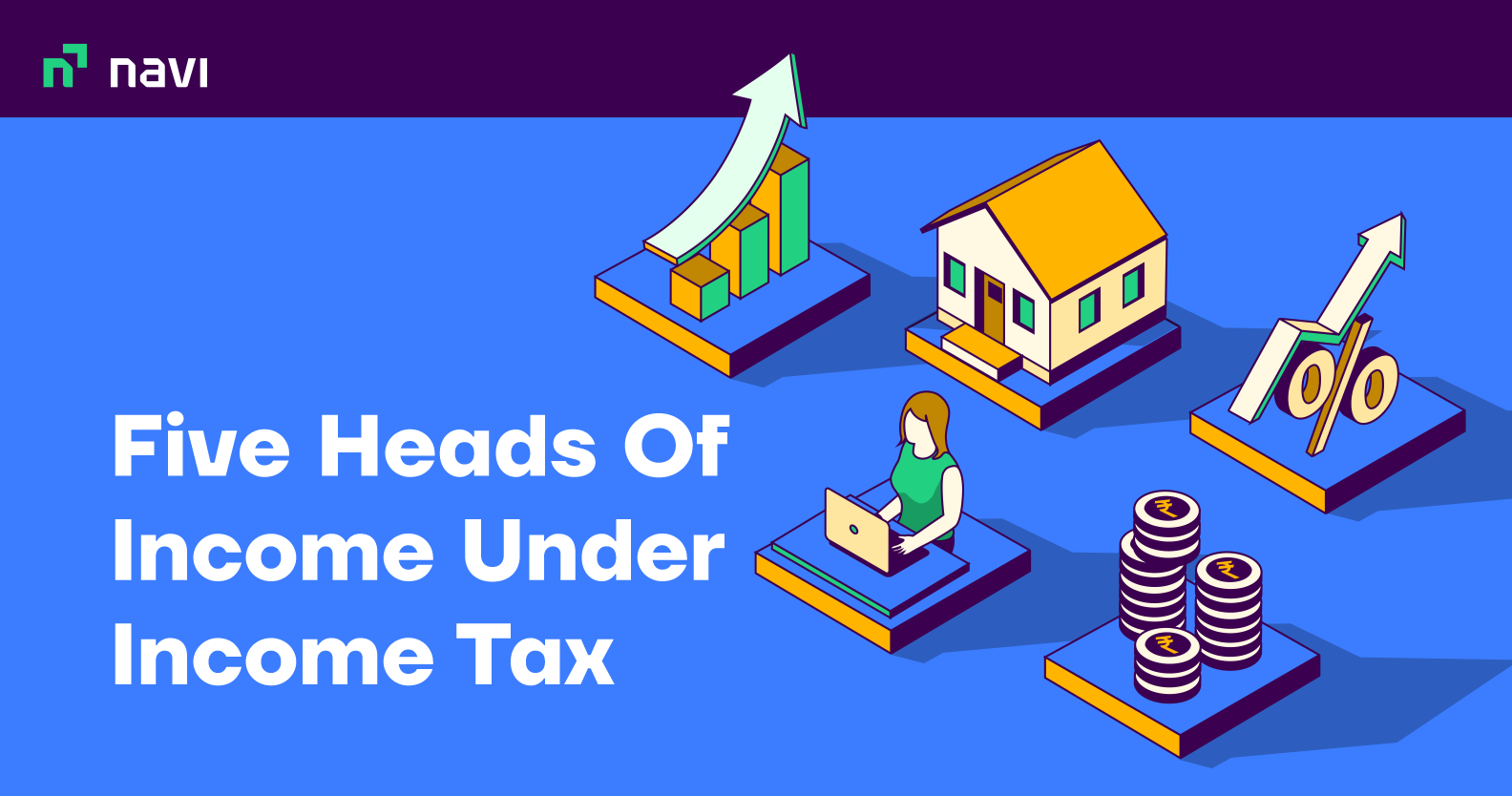5 Heads of Income Under Income Tax Act

What are the Heads of Income Under the Income Tax Act?
For tax computation purposes, the income earned by you during a financial year is divided into 5 heads of income in accordance with Section 14 of the IT Act, 1961. Having a clear understanding of the 5 income tax heads will make it easy for you to accurately declare and calculate your tax obligations for a particular financial year.
The five heads of income are as follows:
- Salary
- House property
- Capital gains
- Profits and gains of business or profession
- Other sources
Let us now look at the individual heads of income under income tax separately in the section below:
5 Heads of Income Tax Act
1. Income from Salary
If you are a professional with a salary as your primary source of income, this head is primarily applicable to you. Under this heading, any compensation paid to you as employee remuneration, is accounted for. However, remember that income will only be considered under this head if there is an employee-employer relationship between the payee and the payer of such salary.
The income under the salary head involves an employee’s basic wages, pension, perquisites, gratuity, commission, annual bonus and any salary paid in advance, if applicable. Upon adding the various components under this head, one can get their gross income.
The following are some of the common allowances for which you can claim tax deductions:
1. HRA
House Rent Allowance (HRA) is generally part of a standard salary package. It is an allowance that employees receive to pay their house rent. Subject to certain conditions, you can claim exemptions for HRA under Section 10 (13A) of I-T Act, 1961. The tax exemption you can claim for HRA will be the lowest among the following:
- HRA received from your employer
- 50% of the basic salary if you live in a metro city or 40% if you live in a non-metro city
- Actual rent paid per month minus 10% of your annual salary
2. Conveyance Allowance
This is an allowance that employers generally pay to compensate for the cost of travel between your home and workplace. Under Section 10 (14(ii)) of I-T Act 1961, you can claim a maximum tax exemption of ₹1,600 per month or ₹19,200 per year.
3. LTA
Leave Travel Allowance or LTA is a part of your compensation which you can use to pay for your personal travel expenses. It is a cost-to-the-company (CTC) component and is usually offered as a yearly benefit. However, note that subject to certain conditions and limits, you can claim tax benefits against LTA for up to 2 leisure trips in a block of 4 calendar years, under Section 10(5).
4. Medical Allowance
This is an allowance that is paid to employees to help them meet their medical expenses. Under Section 17 (2) of I-T Act, 1961, you can claim tax exemption of up to ₹15,000 by producing your supporting medical documents.
Latest Update
Please note that from 2019, tax exemption for medical allowance has been made part of the standard deduction of ₹50,000, which also includes your conveyance allowance.
Also Read
2. Income from House Property
The second of the 5 heads of income includes income from house property. It accounts for all rental income earned by a taxpayer. Sections 22 to 27 of I-T Act, 1961 cover this income head in great detail. However, note that if a taxpayer’s house has not been rented out, then the amount that the person would have received as rent if he/she had let it out, would be considered as taxable income under this head.
This is a head under which tax is calculated on the basis of assumption. Moreover, tax is levied both on income earned from house property and commercial property. The different deductions that come under this head of income are standard deduction, deductions for home loan interest payment, and deduction for municipal tax.
Here, an assessee will also have to pay 10% TDS on rent if the rent value is more than the specified limit.
Here are a few conditions that must be fulfilled for the income to be taxable under this head:
- The assessee should be the house property owner
- House property can include a building, a land appurtenant, or a bungalow
- Individuals must not use their property for any other purposes than residency
3. Income from Capital Gains
If any profit/gain arises from the transfer or sale of a capital asset held as an investment, it is taxable under capital gains. Income or proceeds from a large number of asset classes, such as stocks, bonds, mutual funds, gold, and real estate among others, can be considered under this head. You should also remember that capital gains are generally classified as short- and long-term gains. Based on the asset class, long-term capital gains tax is applied at a maximum rate of 20% on investments held for 3 years or more, while short-term capital gains tax is applied at a maximum rate of 15% on investments held for less than 3 years. However, you must check if the income is eligible for an exemption under Sections 54, 54B, 54EC, 54F, 54D, 54ED, 54GA, or 54G.
4. Income from Profits and Gains of Business/Profession
Your income will be considered under this head if your earnings come from a business or if you are self-employed. To calculate your profit or gross income, you will have to deduct your expenses from the total revenue. Then, tax will be applicable under this income head.
This head will also include incomes, such as bonuses, salary, and profit earned due to a partnership with a business organisation. However, the following rules apply:
- A taxpayer must be controlling the operations of this business or profession
- There business or profession declared under this head must be legitimate
- The business or profession in question must be carried out by the taxpayer themselves.
- The taxpayer must be actively engaged in a particular business or profession for the greater part of the previous year
- If taxpayers operate any other professions or businesses, they must also include it
5. Income from Other Sources
For the earnings that do not belong to any of the heads of income mentioned above, it will fall under the 5th category called income from other sources. Some common examples of earnings that fall under this head include income from lottery, gambling, gift card games, bank deposits, rewards from other sports, and more. Section 56(2) of the IT Act covers these incomes.
Final Word
Now that you know what the various heads of income are, it may be easier for you to classify your income, based on the source, and file your income tax returns without mistakes. It may also be easier for you to forecast your tax liabilities for the year and plan your investments and savings accordingly. Equipped with this knowledge, you may also be able to avoid penalties for non-payment of tax under a particular head of income or incorrect filing of tax.
If you want to maximise your tax savings, you could consider investing in the Navi ELSS Nifty 50 Index Fund scheme, starting at ₹500 or a Navi health insurance plan, with monthly premiums as low as ₹235.
FAQs
Here are some of the incomes chargeable under the earnings from the business head:
1. Profit made from the sale of a license
2. Profit/salary/bonus earned from business partnership
3. Cash received through export
4. Any organisational income
5. Business benefit
All salaried individuals can gain a deduction on their house rent allowance received. However, it is always the least of the following amounts:
1. The actual amount received as HRA
2. 50% of salary including basic salary and DA in metro cities
3. Actual rental expense less 10% of your salary
Conveyance allowance is a travel allowance employers offer to their employees to cover their travel expenses incurred when travelling from their residence to the workplace. The IT Department provides relief under this allowance by exempting up to Rs. 800 per month.
According to Section 54 of Income Tax Act, a HUF or an individual can enjoy tax exemption on the capital gains upon the sale of a house property. However, make sure to reinvest this capital gain to construct or purchase a residential property.
The Income Tax Act of 1961 states that income tax must be levied on the net income of an assessee and not their gross income. An assessee can arrive at the net income after deducting expenses incidental to their employment.
Any individual, association of persons, or business entities, whose gross annual income exceeds the basic exemption limit of ₹3 Lakh, is supposed to pay income tax.
If you are a professional or a business entity with an estimated tax obligation of ₹10,000 or more in a year, then you are supposed to pay income tax in advance. This topic has been dealt with in detail under Section 208 of the Income Tax Act.
The government collects income tax through the following means:
Voluntary declaration and payment of tax by those falling in the taxable bracket
Tax Deducted at Source (TDS)
Tax Collected at Source (TCS)
Rental income generated from a shop will also be considered under Income From House Property head. In fact, any commercial building or property, such as a shop, godown, workshop, hotel, cinema theatre, or even agricultural land, which is owned by an individual, will be taxed under the second head of income.
Read More on Income Tax Act

Customer’s Feedback
No comments found.What is Form 26QB for TDS? How to Download and Submit it?
While purchasing a property, buyers are liable to pay various taxes. The Finance Act, 2013 made TDS... Read More »PF Withdrawal Rules 2023 – Rules, Documents Required and Types
EPF/PF Withdrawal Employees’ Provident Fund (abbreviated as EPF) is a popular retirement sav... Read More »Stamp Duty and Property Registration Charges in Delhi 2023
It is compulsory for property buyers in the Capital to pay stamp duty in Delhi during property regi... Read More »Income Tax Return – Documents, Forms and How to File ITR Online AY 2023-24
In India, it is mandatory for all taxpayers who earn more than the basic tax exemption limit to fil... Read More »What is Section 80CCD – Deductions for National Pension Scheme and Atal Pension Yojana
The Income Tax Act provides a number of deductions and tax benefits to taxpayers, so they can strat... Read More »Tax on Dividend Income: Sources, Tax Rate and TDS on dividend income
What are Dividends? Companies may raise funds for running their operations by selling equity. Th... Read More »Section 112A of Income Tax Act: Taxation on Long-Term Capital Gains
What is Section 112A? Section 112A of the Income Tax Act was announced in Budget 2018 to replace... Read More »Section 206AB of Income Tax Act: Eligibility And TDS Rate
Section 206AB was introduced in the Finance Bill 2021 as a new provision pertaining to higher deduc... Read More »What is a Credit Note in GST – Example, Format and Steps
A GST Credit Note is mandatory for any GST-registered supplier of goods or services. As a supplier,... Read More »Exemptions and Deductions Under Section 10 of Income Tax Act
What Is Section 10 of the Income Tax Act? Section 10 of the Income Tax Act, 1961 provides tax-sa... Read More »Section 57 of the Income-tax Act – Income from Other Sources
It is quite likely that many entities - individuals as well as businesses - have multiple sources o... Read More »What is Dearness Allowance? – Types, Calculation, and Current Rate
What is Dearness Allowance? Dearness Allowance Meaning - Dearness Allowance (DA) is an allowance... Read More »Top 10 Chit Fund Schemes in India in 2023
Chit funds are one of the most popular return-generating saving schemes in India. It is a financial... Read More »10 Best Gold ETFs in India to Invest in April 2023
Gold ETFs or Gold Exchange Traded Funds are passively managed funds that track the price of physica... Read More »10 Best Demat Accounts in India for Beginners in 2023
Creation of Demat accounts revolutionised the way trades were conducted at the stock exchanges. It... Read More »20 Best Index Funds to Invest in India in April 2023
What is an Index Fund? An index fund is a type of mutual fund or exchange-traded fund (ETF) that... Read More »Best Arbitrage Mutual Funds to Invest in India in April 2023
Arbitrage funds are hybrid mutual fund schemes that aim to make low-risk profits by buying and sell... Read More »10 Best SIP Plans in India to Invest in April 2023
What is SIP? SIP or Systematic Investment Plan is a method of investing a fixed amount in ... Read More »10 Best Corporate Bond Funds in India to Invest in April 2023
Corporate bond funds are debt funds that invest at least 80% of the investment corpus in companies ... Read More »10 Best Bank for Savings Account in India [Highest Interest Rate 2023]
Savings account is a type of financial instrument offered by several banks. It lets you safely depo... Read More »






















